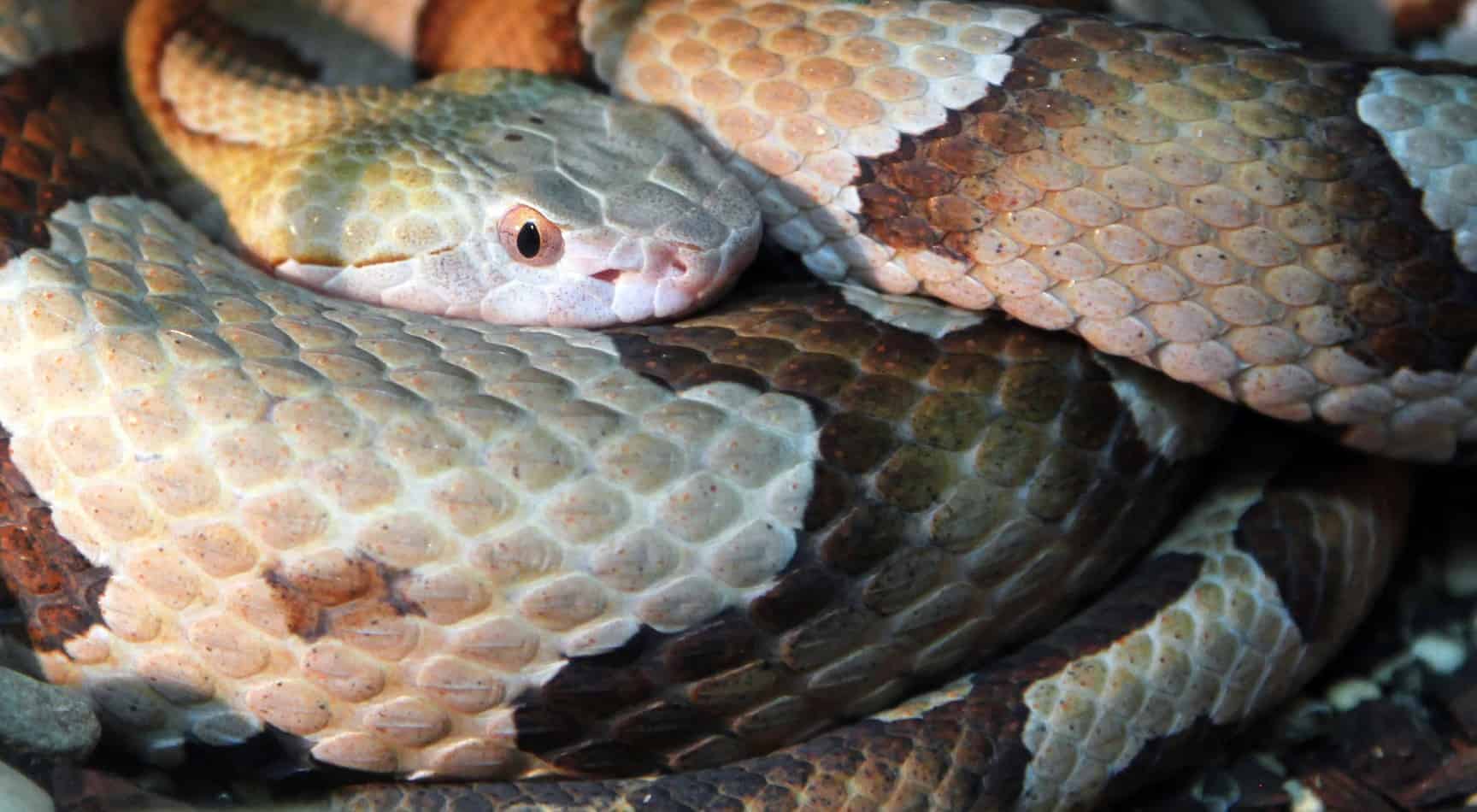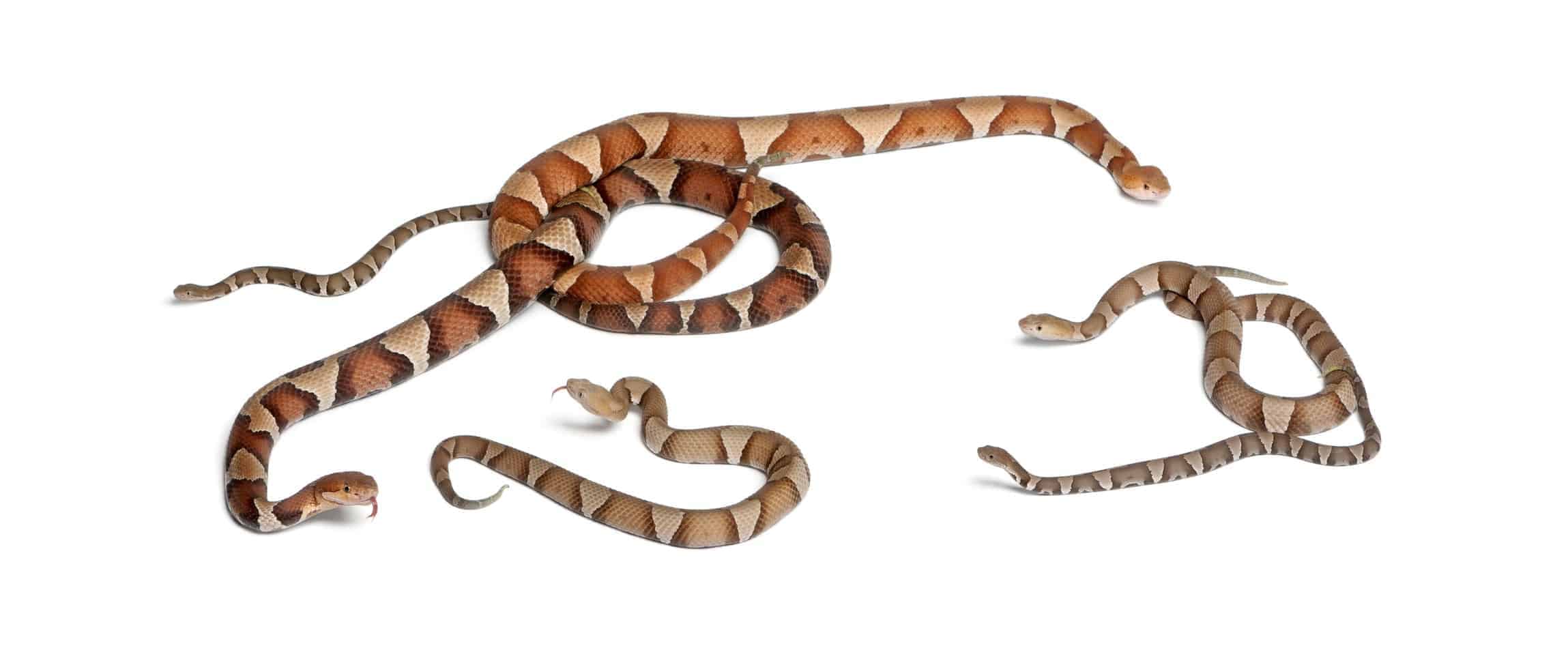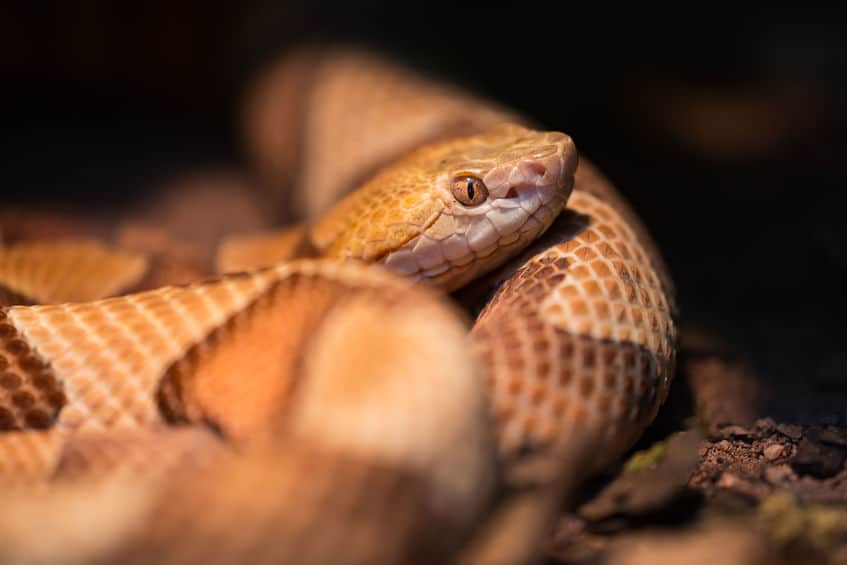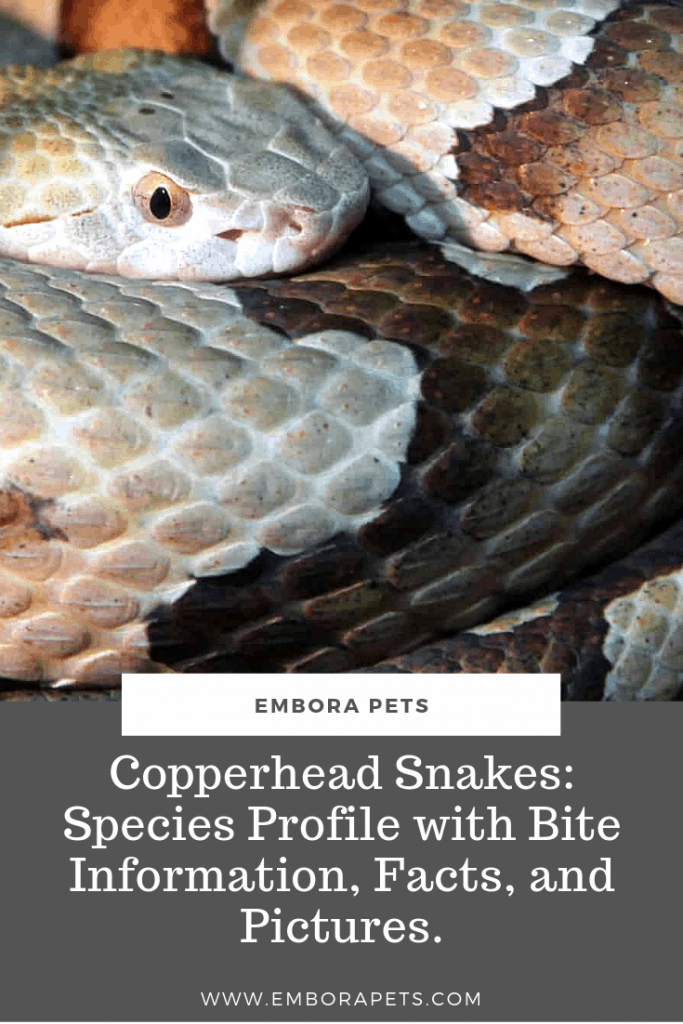Copperhead Snakes- Species Profile with Bite Information, Facts, and Pictures
The copperhead snake is a species that closely resembles the picture Hollywood paints of what a venomous snake is. I was curious about these venomous snakes and decided to do some research.
What do you need to know about copperhead snakes? Copperhead snakes have a distinctive copper-colored head shaped almost like a coffin. These snakes are prevalent throughout the eastern and the southern United States. Copperheads are venomous and can be aggressive, and if you find one in wild, you should leave it be.
This profile article will give a special look into this remarkable species and includes 21 fun facts. If you’re curious about copperhead snakes, read on.
The Basics: Copperhead Snakes
Copperhead snakes (Agkistrodon contortrix) are known as a venomous and very dangerous wild snake. They are pit vipers. Copperheads can be found throughout the southeastern U.S.
Copperhead snakes grow to a length of 2-4 feet, with females tending to be a little larger than the males. This is typical with most snakes, as the female needs to carry more weight in order to give birth.
This particular breed of snake gives live birth, which is not always the case for snakes. Many lay eggs. Copperhead mothers incubate their eggs in their stomachs and give live birth.
A copperhead snake lives, on average, 18 years. This is their average lifespan in the wild
What Does a Baby Copperhead Snake Look Like?
The baby copperhead resembles the adult with a few slight differences. They don the tan and brown skin but will appear to have almost a gray tone over the scales.
While adult copperhead snakes have the hourglass bands consistently across their body, the baby copperhead’s bands stop just above the tail. Their tails are a bright yellow, sometimes vibrant green color that eventually fades into the uniform pattern in adulthood.
Are Copperhead Snakes Born Live or Hatched From an Egg?
Copperheads are ovoviviparous, which means that their eggs incubate inside the mother’s body and the babies are therefore born live. These baby snakes are equipped with both fangs and venom, although the venom is not in the same dosage amount as the adult copperhead.
Even though they carry less venom, the potency of the copperhead remains the same from birth through life. Baby copperheads are fully functional at birth and can hunt and fend for themselves.
The female copperhead will birth her babies in late summer to early Autumn after carrying the eggs for several months.
When born, the copperhead is eight to ten inches (20 to 25 cm). Not all of the baby copperhead snakes will survive their first winter and is one reason the population isn’t as big as it could be.
Mother copperheads leave the babies at birth. The babies are born fully venomous and can take care of themselves. Good thing, considering snakes are not usually the nurturing type.
How Many Babies Does a Female Copperhead Have?
After mating in the spring and sometimes in Autumn, females will give birth to as many as twenty young, but most commonly under ten, baby copperhead snakes.
The female can store sperm it received in Autumn for the whole hibernation season and only fertilize after done hibernating.
The Appearance of a Copperhead
Known and referred to as a medium to a large-sized snake, the copperhead will grow to two to four feet in length when they have reached full adulthood. Thick bodied and quite muscular, they have keeled scales. The male is distinguished from the female in that it has a longer tail, but the female is longer overall.
As with other pit vipers, copperhead snakes have a distinctive triangular head with a narrow neck that further defines the head from the rest of the body.
Here, you can read an article we wrote all about how to identify a copperhead snake, including how to avoid these dangerous snakes.
They have the cat eye shaped vertical pupils and carry heat sensory pits below its eyes.
The Habitat and Subspecies of a Copperhead Snake
The copperhead snake most often can be found in forested areas, especially near bodies of water like a stream or lake just below the timberline. This geographical zone is called the ‘Montane’ area.
What they really like above anything else is ecotones or areas of transition between two zones. This is why copperheads can be found in mountainous regions, desert oases, rocky areas, wooded lands, thickets, and by streams and canyons.
Plotted out, copperhead snakes cover a large region within North America, spanning from Southern New England all the way down to Texas and Mexico. This includes the eastern coast from Massachusetts to Georgia. They are absent in the southern part of Georgia and all of Florida.
There are a few subspecies of the copperhead snake, the northern, northwestern, southern and two southwestern subspecies. The northern copperhead snake is the most common and has the largest range- from Alabama to Massachusetts to Illinois.
Copperheads play a vital part in the ecosystem. Their diet consists 90 percent of rodents and they are one of a group of snakes that keep farm damage and rodent populations low.They also love to eat frogs, birds, lizards, salamanders, large insects and small snakes, caterpillars, and even cicadas.
On the other end, copperheads are the prey of many animals, including other snakes like king snakes and cottonmouths. They are also hunted by crows, hawks, coyotes, and other such predators. So in their turn, copperheads keep the ecosystem thriving as both prey and predator.
Copperheads like other snakes have several nicknames by which they are known. Here are some of those names: chunk head snakes, death adder snakes, (dry-land) moccasin snakes, highland moccasin, narrow-banded copperhead, northern copperhead, pilot snake, poplar leaf snakes, red oak snakes, red snakes, southeastern copperhead, white oak snakes, American copperhead, southern copperhead and cantil
When copperheads strike a prey, they release it and wait for the venom to do its trick. They’ll track down the mouse or whatever creature and then once dead, will swallow it whole.
What Happens When Someone is Bitten by a Copperhead Snake?
Copperhead snakes are both primed to bite and reluctant to attack. Let me explain. They do not like humans and will generally avoid humans at all costs and camouflage into their surroundings.
However, this expert camouflage is in part responsible for countless bites. It’s so effective that they can be nearly invisible to some people. Many times the copperhead will strike at a person who got too close and didn’t see the snake. But really, it’s the copperhead’s fault for hiding so well, isn’t it?
Other snakes may use other tactics before striking a potential predator. The copperhead is different in this regard as well. They are naturally inclined to bite first and ask questions later. Because they will give no warning, the copperhead holds the largest amount of snake bites in the United States.
Unlike other venomous snakes such as the Coral snake, the Copperhead snakes have an efficient venom delivery system. Copperhead snakes don’t have teeth but do have impressive and long fangs. Their fangs are positioned at the front of the jaw and can swivel back to allow the copperhead snake to close its mouth.
As all snakes must swallow their food whole, they must effectively capture and not lose their prey. The copperhead snake is quite successful among snakes which is due to the massive amounts of venom distributed quickly through its long fangs.
These lethal doses kill prey at a devastating speed. As impressive as this may sound, the amount of venom a single Copperhead snake can deliver is insufficient to kill an otherwise healthy adult human.
However, a bite from a copperhead snake doesn’t go without consequences. The venom of a copperhead snake is hemolytic meaning it gets into the bloodstream and breaks down red blood cells causing hemorrhaging in the body as it spreads and must be treated immediately.
The copperhead snake is quite capable of inducing intense pain, tingling, throbbing, swelling and severe nausea in adults.
It’s not uncommon to think a snake bite came from a copperhead snake when in fact was a rattlesnake. For example, the venom in a copperhead thins the blood to cause uncontrollable internal and sometimes external bleeding causing blood splotches to appear under the skin.
Whereas copperhead snake venom does this, rattlesnake venom is necrotic or flesh-eating and causes what looks like dark purple or hot red marks signifying that the flesh is inflamed and/or dead.
While rarely lethal, a Copperhead snake bite can be damaging to muscle and bone tissue, especially when the bite occurs in the outer extremities such as the hands and feet, areas in which there is not a large muscle mass to absorb the venom.
From what I gathered, the effects of a bite can last up to eight days even with antivenom administered. These bites are no joke! Copperheads are not snakes to mess around with.
Those most at risk of damage or death from a copperhead bite are children, elderly, and people with a comprised immune system. Children may also be more likely to be bitten because they may not recognize the copperhead snake for the danger it is.
If at all possible, it can help the medical professionals know how best to treat the wounds if you have a picture or the actual animal is caught alive or has died already. Only attempt to catch a copperhead snake with proper thick gloves and with expertise, and don’t waste time trying to catch the snake if someone needs medical attention.
A bite from any venomous snake should be taken very seriously and immediate medical attention should be sought.
In this article, you can learn about what happens when a dog is bitten by a copperhead snake, including what symptoms to look for.
What Should I do if I am Bitten by a Copperhead Snake?
Immobilize the affected area and wrap a bandage around the limb. Be sure to keep the bite location lower than the heart. If it is higher than the heart, it can spread much quicker.
Do not try to suck the venom out of the bite wound. This does not work and will waste time that could be used in getting help. Not only that, but you could end up with venom in your mouth which could cause serious damage as well.
Seek immediate medical attention and have someone else drive you there when possible. After examining the bite, the doctors may keep you in the hospital to keep a close eye on spreading symptoms. They will also administer antivenom to fight the effects of the venom.
Never go after the snake or try to kill it. This is how most bites occur.
What Other Snakes Look Like a Copperhead?
There are several snakes that commonly are confused with the copperhead snake. These snakes are:
- The northern water snake
- Northern black racer
- Eastern milk snake
- Eastern hognose snake
- The red corn snake
- Eastern rat snake
- The northern mole kingsnake
- Cottonmouth snake
The biggest identifiable difference between these harmless or mildly venomous snakes, such as the eastern hognose snake and the copperhead, is the hourglass shape found on the copperhead. Skinny in the middle of the snake near the spine and widening down the sides to the belly, this unmistakable identifier separates the copperhead from the rest.
Other traits that only the copperhead snake possess is a triangular or “arrowhead” shaped head since they are pit vipers. They also have yellow eyes with black slit pupils. This is unique to the copperhead from other look-alikes.
The young copperhead snake looks like the more aggressive cottonmouth snake with the exception of the copperhead’s shorter length and different in mouth shape.
The copperhead’s mouth goes further back from the nose as well as a more pointed slope instead of the blunt face of a cottonmouth snake.
21 Interesting Facts about the Copperhead Snake
Now that you know what you need to about copperhead snakes, here are some fun facts to tag along.
#1: Copperhead snakes hunt alone.
Most snakes are either social or not social with other snakes. These guys are unique because they are a little of both, but it’s curious to note that they still prefer to hunt alone. This is important for their hunting because they are ambush hunters who wait silently for prey to cross their paths.
#2: Copperheads “hibernate” in communal dens, and they sometimes hibernate with other snake species.
Again, copperheads are somewhat social snakes. While the term “hibernation” isn’t exactly accurate for snakes (they brumate, which is just becoming less active in cold weather, not sleeping), it’s strange that they would join other snake species during this vulnerable time.
#3: Copperheads return to the same den every year.
Most snakes aren’t homebodies. They travel as they need and often sleep in whatever shelter they can find. Not all snake species build dens. But copperheads do, and they like to keep the ones they build. This also means that when they return to a den, they are likely returning to a brumation community.
#4: Out of all the snakes in North America, these are most likely to bite.
These snakes are easily threatened and will strike without question. Not only do they give no warning, but they tend to bite faster and more frequently than any other snake species in the U.S. Keep a sharp eye out when hiking if you live in an area where they are common.
#5: Copperhead hatchlings are very creative.
Baby copperhead snakes are pretty small, so they can’t hunt quite the same as their parents. Besides, they don’t have parents around to teach them how to hunt anyway. Baby copperheads will lay low and wave their yellow tails in the air to attract prey. They attack once the prey has become distracted.
#6: These snakes are proportional.
The length of a copperhead’s fangs is related to the length of the snake — the longer the snake, the longer the fangs. Not all snakes are like this. Some species have very small fangs or no fangs at all, so this is a pretty unique feature of the copperhead snake.
#7: Copperheads are Historical
During the Civil War, Nothern Democrats who disagreed with President Lincoln and the war were nicknamed “Copperheads” after the snake. Maybe because people thought they were just as sneaky and dangerous as the snake.
#8: The penny is sometimes referred to as a copperhead.
Where the snake looks like it has copper on its head, pennies have a head on the copper. That is the only reason they share the name, but it’s a funny little connection. Especially considering that Abraham Lincoln is on the “copperhead coin” and his enemies, as we just learned, were called copperheads.
#9: They can “store” eggs.
Female copperheads can store sperm for several months before fertilizing the eggs, and the egg will be fine.
#10: Their venom could be very useful.
The venom of the southern copperhead has been found to hold a protein called “contortrostatin” that halts the growth of cancer cells in mice. While more research is being done on this potentially healing property, the dangers of copperhead venom are still being tested and altered.
#11: The females are feisty.
When mating, the female may fight the male and will reject any who back down from a fight. This is mainly because they are testing how strong the male is in an effort to identify if they are suitable to reproduce with.
#12: They bite more than they kill.
Chances of a copperhead snake bite being fatal are less than two percent. While they are the most likely venomous snake to bite in North America, they are not the ones who will most likely kill you–but you should still avoid them as much as you can. These snakes are aggressive.
#13: Copperheads are venomous even in death.
Even after being decapitated for hours, the head can still bite and envenomate. This is a big cause for snake bites when people try to remove dead snakes from roads or just “get a good look” at the supposedly-dead creatures. Even if a snake looks dead, copperhead or not, leave it alone.
#14: They are stealthy.
Copperheads use a wait-and-ambush method of hunting, using their camouflage to lie in wait for prey. Some snakes will envenomate their prey by chasing it down and finally sinking their fangs into it, but copperheads prefer a careful and calculated approach.
#15: Heat makes them sleepy.
They become nocturnal in the Summer months. From June-August, or when the weather is warmer, you can expect these guys to be out hunting when the sun goes down and it cools off.
#16. Copperhead snakes are excellent swimmers.
If snakes are scary on their own, swimming snakes are scarier. Copperheads will still bite in the water, so if you do see one of these amazing creatures in a creek while you’re crossing on a hike, don’t try splashing it or picking it up with a stick. They move faster in water.
#17: Its tongue helps it hunt.
This snake constantly flickers its tongue out to detect odors. Doing so helps the copperhead hunt. This goes back to the Hollywood depiction of snakes, with their tongues always going in and out. That is taken a great deal from this attribute of this particular snake.
#18: They are not blockbuster hits.
In June 2008, the tv movie “Copperhead” depicted a western town attacked by copperhead snakes. It did quite poorly- 3.8/10 stars. This is not to be confused with the “Copperhead” that came out in 2013, which was a drama set in the Civil War time period exploring freedom of speech. That one did all right but had little to do with actual copperhead snakes.
#19: They have multiple names.
Its scientific name is
#20: Their appetite gets smaller as they get older.
Adult copperheads may only eat ten to twelve meals a year.
#21: Their “defensive” smell resembles a fruit.
When threatened, copperhead snakes can emit an odor that smells similar to cucumbers.
Related Questions
Are baby copperhead snakes more poisonous than adult copperheads? Baby copperheads aren’t more poisonous. In fact, as the copperhead snake grows and develops, the capacity for venom increases. Another myth, that baby copperhead snakes use their tail to sting is false.
What predators kill the copperhead snake? Large bullfrogs, alligators, crows, hawks, owls, opossums, feral cats, kingsnakes, black racer snakes, and coyotes have all been known to attack, kill, and even eat copperheads.
Are the cottonmouth snake and the copperhead snake the same? While both are semi-aquatic venomous snakes with similar coloring and patterns, they are different species. The cottonmouth snake is also much more venomous.




